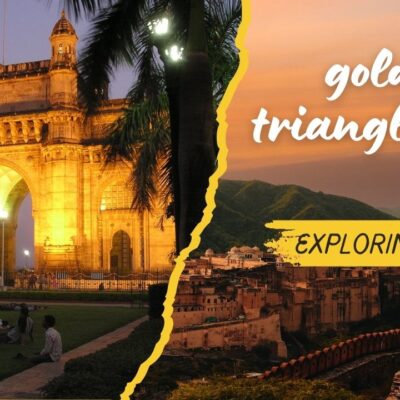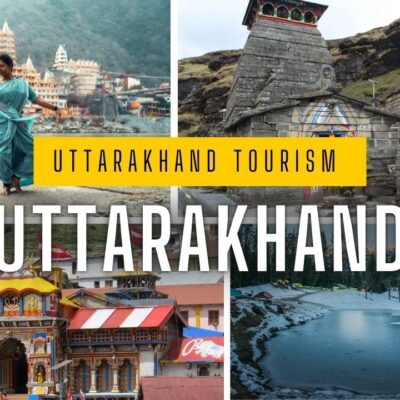Table of Contents
ToggleIntroduction to Uttarakhand Tourism
Uttarakhand Tourism reflects the unique blend of ancient spirituality, pristine nature, and high-altitude adventure. Located in the northern part of India, this Himalayan state draws visitors year-round with its serene hill stations, sacred temples, wildlife reserves, rivers, and trekking routes. Whether you are seeking quiet in the lap of nature or thrills in the mountains, Uttarakhand Tourism offers something real, rooted, and unforgettable.
Spiritual Trails and Sacred Towns
One of the most significant aspects of Uttarakhand Tourism is its strong spiritual foundation. The region is home to many important Hindu pilgrimage sites, and each destination holds deep cultural significance.
Char Dham Yatra:
The Char Dham circuit—Yamunotri, Gangotri, Kedarnath, and Badrinath—is among the holiest pilgrimages in India. Pilgrims trek through steep paths, rugged terrain, and dense pine forests to seek blessings.
Haridwar and Rishikesh:
These twin towns along the Ganges River are central to spiritual life in Uttarakhand. Haridwar is known for the Ganga Aarti at Har Ki Pauri, while Rishikesh draws yogis and seekers from all over the world.
Hemkund Sahib:
A sacred Sikh site located at an altitude of 4,329 meters, Hemkund Sahib is visited by thousands of devotees each year. The challenging trek adds to the spiritual intensity of the journey.
Hill Stations that Keep Things Real
Uttarakhand Tourism is synonymous with quiet hill towns that haven’t lost their original charm. The hills here are more than just tourist hubs—they are living communities, rich in culture and local flavors.
Mussoorie:
Often called the ‘Queen of the Hills’, Mussoorie still holds its colonial charm. With scenic spots like Kempty Falls and Gun Hill, it’s perfect for slow walks and relaxed evenings.
Nainital:
Centered around a beautiful pear-shaped lake, Nainital is known for boating, traditional markets, and Himalayan views. It is one of the most loved destinations in Uttarakhand Tourism.
Almora and Ranikhet:
For travelers who want to go beyond the usual, Almora and Ranikhet offer authentic Kumaoni experiences. These towns showcase local art, craft, and a lifestyle that’s deeply tied to the mountains.
Uttarakhand Tourism and Nature Reserves
Uttarakhand is a treasure trove of biodiversity. Its national parks and wildlife sanctuaries are crucial to preserving endangered species and rare ecosystems.
Jim Corbett National Park:
India’s first national park, Jim Corbett is an iconic wildlife destination. Located in the foothills of the Himalayas, it is known for Bengal tigers, elephants, leopards, and over 600 bird species.
Valley of Flowers:
A UNESCO World Heritage Site, this valley comes alive with blooming alpine flowers during the monsoon months. It’s one of the most visually stunning destinations under Uttarakhand Tourism.
Binsar Wildlife Sanctuary:
Perched at an altitude of 2,400 meters, Binsar is rich in birdlife and offers panoramic views of Himalayan peaks such as Nanda Devi, Trishul, and Panchachuli.
Adventure in the Himalayas
Uttarakhand Tourism attracts a large number of thrill-seekers throughout the year. The state’s varied landscape—ranging from snowy peaks to turbulent rivers—makes it a natural playground for adventure sports.
Trekking Routes:
Some of India’s most rewarding treks are found in Uttarakhand. Popular ones include:
-
Kedarkantha Trek
-
Har Ki Dun
-
Roopkund Lake
-
Kuari Pass
White Water Rafting:
Rishikesh is considered the rafting capital of India. The stretch from Shivpuri to Rishikesh offers Grade II to Grade IV rapids, perfect for both beginners and seasoned rafters.
Camping and Rock Climbing:
Destinations like Chopta, Auli, and Mukteshwar provide great opportunities for camping under the stars and trying your hand at rock climbing or rappelling.
Unique Cultural Touches in Uttarakhand
Culture is the soul of Uttarakhand Tourism. The people here carry forward ancient traditions, crafts, and cuisines that reflect the mountain spirit.
Local Festivals:
Festivals like Harela, Nanda Devi Raj Jat, and Bikhauti celebrate local deities, agricultural seasons, and community bonds.
Traditional Cuisine:
Food here is wholesome and made with seasonal, locally-sourced ingredients. A few must-try dishes include:
-
Aloo Ke Gutke (spicy potatoes)
-
Kafuli (spinach curry)
-
Jhangora Kheer (millet dessert)
Folk Music and Dance:
Uttarakhand’s folk music has a calming rhythm that matches the mountains. Instruments like the ‘dhol damau’ and folk dances such as Chholiya and Jhora are still part of weddings and local gatherings.
Offbeat Villages and Quiet Corners
Uttarakhand Tourism goes beyond famous names. The state is dotted with lesser-known places that give you a closer view of local life.
Munsiyari:
Located near the Indo-Tibet border, Munsiyari offers jaw-dropping views of the Panchachuli peaks and is a base for high-altitude treks.
Chaukori:
Set in the Kumaon hills, Chaukori is peaceful, with tea gardens and clear sunrise views over the Himalayas. It’s a great spot for writers, thinkers, and those who like solitude.
Kanatal and Dhanaulti:
Perfect for weekend getaways, these small hill retreats offer eco-parks, apple orchards, and homestays where hospitality feels personal.
Winter in Uttarakhand: A Different World
Uttarakhand Tourism in winter brings a new personality. Snow-covered slopes and fog-wrapped pine forests offer a quiet, frozen beauty.
Auli:
Known for its ski slopes, Auli is one of the few places in India with proper infrastructure for snow sports. January and February are ideal for skiing.
Chopta in Winter:
Known as the ‘Mini Switzerland’ of India, Chopta transforms into a snowy paradise, attracting winter trekkers headed to Tungnath—the highest Shiva temple in the world.
Snowbound Temples and Trails:
Temples like Kedarnath are closed in winter, but treks around Deoria Tal and Khaliya Top give a taste of alpine landscapes during this season.
Responsible Travel in Uttarakhand
With the rise in visitors, there’s an increasing need to promote responsible Uttarakhand Tourism. The local government and communities are encouraging sustainable practices.
Eco-Tourism Initiatives:
Villages are setting up eco-stays, organic farms, and solar-powered guest houses. Tourists can now participate in tree-planting and village clean-up drives.
Plastic-Free Zones:
Sensitive areas like the Valley of Flowers and Tungnath have restricted plastic usage. Travelers are urged to carry reusable water bottles and eco-friendly bags.
Local Employment:
Choosing homestays, local guides, and small family-run cafes ensures that tourism directly supports local livelihoods.
Getting Around Uttarakhand
Accessibility has improved in recent years, making it easier to plan trips across different zones of the state.
By Road:
The state has a strong network of state-run and private buses. Shared jeeps are also common in remote villages.
By Rail:
Major railheads include Haridwar, Kathgodam, and Dehradun. From here, taxis or buses are easily available to reach higher altitudes.
By Air:
Jolly Grant Airport in Dehradun connects Uttarakhand with Delhi and other metros. Pantnagar Airport is useful for accessing Kumaon.
Best Time to Visit Uttarakhand
Uttarakhand Tourism is active all year, but different seasons offer different experiences.
-
March to June: Ideal for trekking, nature walks, and wildlife spotting.
-
July to September: Great for flower valleys and rural retreats but some places may be affected by monsoons.
-
October to December: Perfect for autumn treks, temple visits, and clear mountain views.
-
January to February: Best for snow sports and serene winter landscapes.
Final Thoughts on Uttarakhand Tourism
Uttarakhand Tourism is more than travel—it’s a return to something timeless. From sacred rivers to remote trails, this state brings you face to face with simplicity, silence, and nature’s raw rhythm. Whether you stay in a wooden homestay or climb a snowy peak, every moment here feels real, grounded, and meaningful.
If you’re looking for a place that balances inner peace, outer adventure, and genuine local hospitality, Uttarakhand will meet you with open arms and open skies.





